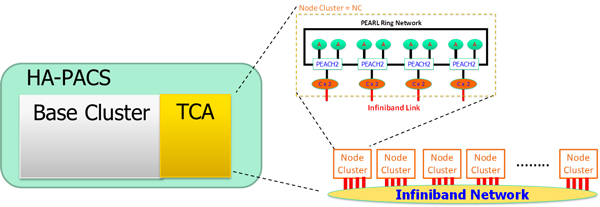From the approach of “Interdisciplinary Computational Science,” cooperation of computational sciences center around high performance computing system and cutting-edge computer science, work on realization of Exa-Flops performance.
Especially, large-scale parallel systems with a focus on accelerator is expected to perform maximum performance in limited power, and below themes are positioned as important issues.
ー Proposal of TCA(Tightly Coupled Accelerators) to allow the construction of large-scale systems and enhance communication performance.
– Acceleration and large-scaling of applications of Computational Sciences based on TCA.
These challenges become foundation of the exascale system, and aim to
– steady development of advanced computational science by the demonstration system.
– enhance the center of multidisciplinary cutting-edge computational science education and research.
– foster human resources in the future computational science.
3 Themes of HA-PACS Project
Theme 1
Innovation toward Exa-Scale Computing Sciences
Research and development of application algorithm on computational sciences, accelerated by TCA. Develop the cutting edge region with Grand Challenge Applications in 3 focused fields of Center for Computational Sciences by HA-PACS.
Theme 2
Research and Development of Tightly Coupled Accelerators and Demonstration System
Research and Development of TCA(Tightly Coupled Accelerators) Architecture
We develop “PEARL(PCI-Express Adaptive and Reliable Link)”, which directly connect between accelerators.
Accelerators are based on GPGPU, and consider about further accelerators like Grape-DR.
In addition, by using “PEACH2 (PCI-Express Adaptive Communication Hub ver.2)” chip enables direct communication between accelerators, improve the performance of the communication, development of new applications.
Research and Development of Tightly Coupled Accelerators Demonstration System “HA-PACS”
Develop a system of one petaflops scale system by Node Cluster with acceleration mechanism described above, paralleled by Infiniband network.
Theme 3
Research and Development of the Basic Software to Support Programming
To available to use TCA on user applications, develop system firmware, system software, and API. TCA is not only high performance communication mechanism, but also the new concept that enable active and ultra high speed communication between accelerators. For this reason, control is complicated, and system software is required to build in various layers. We will develop these software and high speed parallel applications.
Background and Need
- Computational Sciences, the most important “Experimental/Observation System”, open up the frontier of science in the 21st century.
- K computer(10 petaflops) will be completed in 2012. However, exaflops (100 times of 10 peta) is already aimed at home and abroad.
- Accelerators are promising means to exascale system implementation. To take advantage of accelerators, it is necessary to devise algorithms and programming.
- Center for Computational Sciences, University of Tsukuba combines the researchers of high performance computing and a wide range of advanced computing sciences, and perform together.
- Center for Computational Sciences combines researchers of high performance computing engineering and a wide range of advanced computing sciences. So far, we have developed a number of computers. (CP-PACS was ranked No.1 of TOP500 in 1996.)
Expected Outcome
- > Develop the unexplored regions of the state of the art knowledge by HA-PACS.
- > Creates life innovation by applications of key issues, and help to strengthen the growth of our country through science and technology.
- > With supercomputer superior power efficiency with accelerators, contributing to the Green ICT innovation.
- > Develop human resources for “interdisciplinary computational science”, necessary for computational science of the future.
Challenges and Solutions
<Challange 1> Not all applications can be used in TCA
Solution: Take advantage of promotion structure of Center for Computational Sciences for interdisciplinary computational science greatly, select applications to improve performance significantly, review models, conduct research for algorithms.
<Challange 2> Communication speed is the bottleneck at current accelerator(GPU)
Solution: We will develop a tightly coupled parallel architecture acceleration mechanism to greatly improve communication speed, by directly linked accelerators(GPU) with our developments of the network link.
<Challange 3> Programming to manage accelerator is difficult
solution: Develop programming languages and basic software to ease the development of software for accelerators, with our developments of the parallel programming languages.

